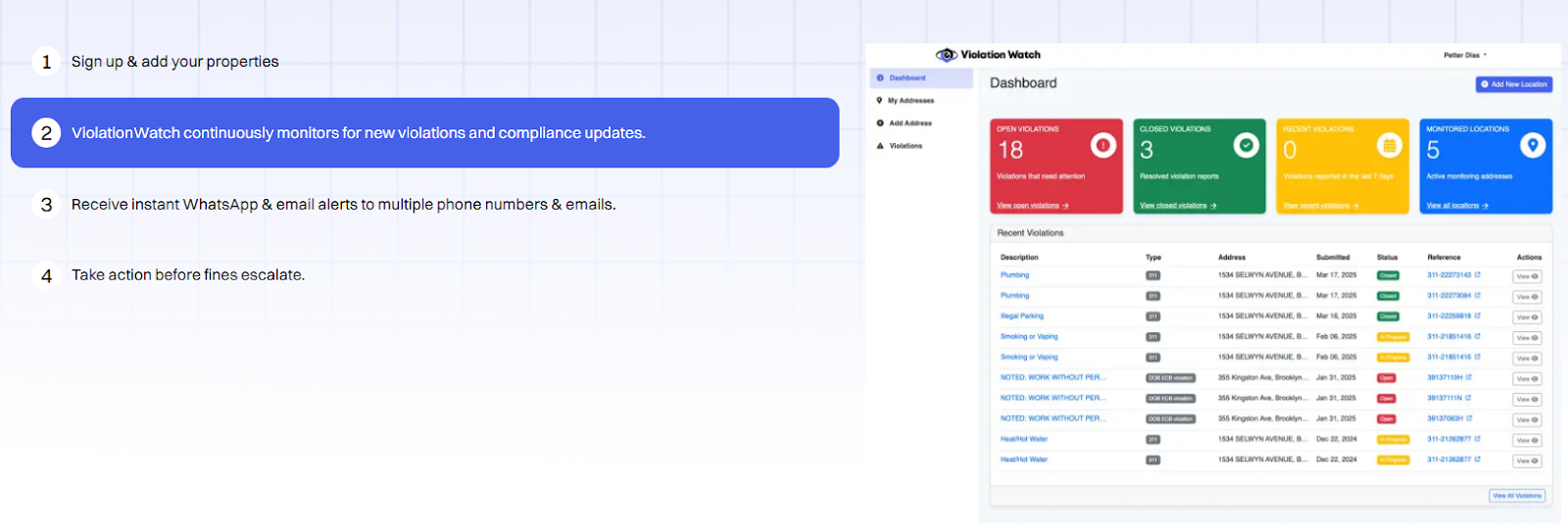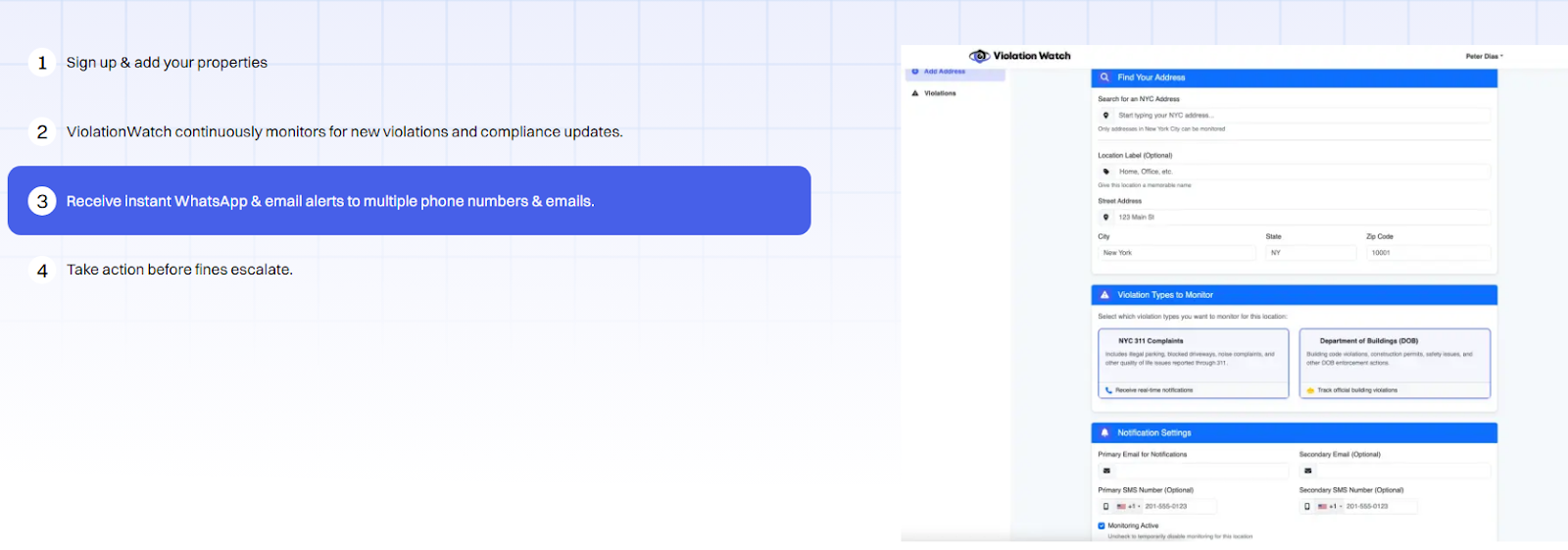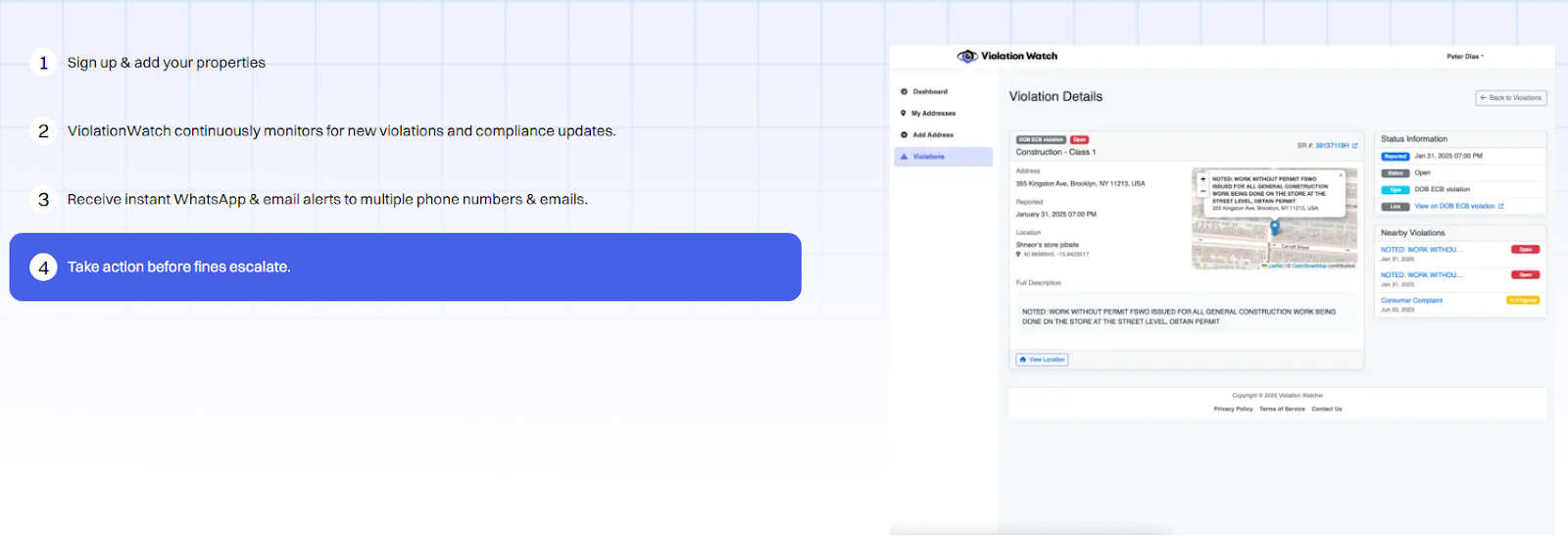Landlords don’t always fix what they’re supposed to. Some ignore leaks. Others stall on heat, hot water, or safety hazards. So, you pick up the phone and call 311.
But here’s where most people get it wrong: the call doesn’t solve the problem. It triggers a chain reaction—one that unfolds through multiple agencies, deadlines, and violations. The question isn’t whether you should call. The question is: what exactly happens after you do?
This guide breaks it down—not just what to expect, but what to watch for. We’ll show you how the city responds, what your landlord faces, and how to stay ahead once the gears start turning.
Here’s what we’ll cover:
- What 311 does—and doesn’t do—for tenant complaints
- Step-by-step: What happens after you call 311
- How your report gets routed through agencies like HPD and DOB
- What landlords face once the city gets involved
- Timelines: what happens in 24 hours vs. 30 days
- Risks, delays, and what tenants often miss
- When to call 311—and when not to
- A smarter way to track what happens after the call
Let’s break down the process, start to finish.
What 311 Actually Does—and Where It Stops
Calling 311 feels like taking control. You report the issue, document the problem, and expect the city to handle the rest. That’s half true.
311 works as a central intake system—a way for tenants to flag housing problems and push them into the city’s enforcement pipeline. It connects you to the right agency without needing to figure out which one yourself. But the system doesn’t enforce anything directly. It routes, records, and redirects.
Let’s break it down.
What 311 does for tenant complaints
- Creates an official complaint log: Every call or online submission gets recorded with a case number. That’s the first breadcrumb in the city’s system.
- Routes your issue to a relevant city agency: 311 doesn’t investigate. Instead, it sends your report to the right department—usually HPD for issues like heat, pests, broken plumbing, or mold, and DOB for structural or safety problems.
- Provides follow-up access to complaint status: You can search your case by number and see status updates like “Open,” “In Progress,” or “Closed.”
- May schedule an inspection on behalf of the agency: If the complaint qualifies, the assigned agency might send an inspector to verify the issue.
What 311 doesn’t do
- It won’t enforce violations: 311 has no power to force repairs or penalize landlords. That responsibility falls on the agency that receives the complaint.
- It doesn’t track outcomes beyond the initial complaint: Once the agency takes over, 311’s role is done. It won’t tell you if the landlord fixed the issue, if a violation was issued, or what fines followed.
- It won’t escalate unresolved issues: If nothing happens after your call, 311 won’t follow up. You’ll need to contact the agency directly or file another complaint.
- It doesn’t offer legal protection or rent relief: 311 is not legal aid. It won’t stop retaliation or help you recover rent tied to unresolved problems.
Why does this matters? Many tenants call 311 expecting results. But what they’re actually doing is entering a complaint into a complex, multi-agency workflow. That’s valuable—but only if you know how the system works, and what to watch for once your issue leaves the 311 line.
What Really Happens After You Call 311

Calling 311 is the spark. What follows is a chain of steps that moves your complaint through the city’s housing enforcement system—quietly, but with weight.
Once your report is logged, you’re no longer dealing with 311. The complaint leaves the intake center and enters the machinery of city agencies. This is where real enforcement begins, and knowing how each piece works can help you keep control of the process.
Here’s how it plays out.
- Your complaint gets routed: 311 takes your issue and pushes it to the agency that handles your type of problem. For heating, mold, leaks, or pests, that’s usually HPD. For structural damage, illegal work, or egress violations, it’s likely DOB. You’ll get a reference number. That’s your breadcrumb trail.
- The agency logs and prioritizes the issue: Not all complaints move at the same speed. Agencies use internal risk levels to sort urgency. No heat in winter? That rises to the top. A minor paint issue? Not so much. Once logged, your complaint sits in a queue waiting for the next available inspector or action.
- They try to reach the landlord: The agency typically reaches out to the owner or property manager first. Sometimes it’s a courtesy notice. Sometimes it’s a warning. Either way, it puts them on record that a complaint has been filed. In some cases, this alone gets results. But often, nothing moves until an inspector sees the problem for themselves.
- An inspection is scheduled (or not): If the agency decides your complaint warrants inspection, they’ll schedule one. You don’t always get a heads-up. Inspectors may show up unannounced, especially if the condition poses a health or safety risk. If they find a violation, the next step is formal enforcement.
- Violations are issued: The inspector documents the issue. Photos, reports, timestamps. If they confirm a violation, it’s issued to the landlord. This becomes a matter of public record and starts the clock on compliance. Each violation includes a required correction deadline and potential penalties if ignored.
- The landlord responds (or doesn’t): Some landlords fix the issue right away to avoid fines or further enforcement. Others stall. If they fail to act, the agency may escalate with hearings, penalties, or liens. The city won’t chase down tenants for updates. If you’re not actively watching the case, it can slip into limbo.
- The agency closes or escalates the case: Once the correction is made and verified, the agency can close the case. If not, they escalate, potentially involving court hearings or emergency repair programs. No updates are sent automatically. You have to check manually or risk missing critical changes.
This is the actual process behind the complaint you file. It’s not instant, and it’s rarely simple—but understanding each step gives you the clarity to follow up, act strategically, and avoid getting left in the dark.
Where Your 311 Complaint Actually Goes
Once you file a 311 complaint, the city doesn’t sit on it—it moves it. Fast. But it doesn’t go to one single team. It’s route-based on the nature of the issue.
Every complaint ends up with a specific city agency, and each agency has its own system, timelines, and inspection protocols. Knowing where your issue lands is critical if you want to track what’s happening—or push for action when things stall.
Let’s break down the key players.
Housing Preservation and Development (HPD)
If your complaint deals with basic living conditions, odds are it lands here.
HPD handles:
- No heat or hot water
- Mold, leaks, or visible water damage
- Rodents, roaches, or infestations
- Broken windows, doors, or locks
- Illegal occupancy issues
Once HPD receives the complaint, it may attempt phone or written contact with the landlord. In higher-priority cases, they’ll dispatch an inspector to verify the condition.
If the problem violates the Housing Maintenance Code, a formal violation is issued.
Department of Buildings (DOB)
DOB steps in when the issue relates to structural integrity, building code violations, or construction hazards. That includes:
- Unpermitted or unsafe construction
- Dangerous facades or cracked walls
- Fire egress obstructions
- Illegal gas or electrical work
- Unsafe scaffolding or sidewalk sheds
DOB’s process is stricter. Inspectors are often specialists, and follow-up is tied to safety risk. If a violation is found, it may require permits, hearings, or structural remediation.
Other Agencies That May Be Involved
Not all complaints end up with HPD or DOB. Some are handled by:
- FDNY – blocked fire exits, fire hazards, missing extinguishers
- DOH – unsanitary conditions, standing water, hazardous waste
- DEP – noise complaints, asbestos, lead, or environmental concerns
- DOT or DSNY – sidewalk issues, illegal dumping, sanitation problems
Each agency works with its own case structure and inspection schedule. That’s why two tenants in the same building can file complaints and get very different timelines and outcomes.
This routing process is what sets the stage for enforcement. But it also creates confusion. Multiple complaints, multiple agencies, different deadlines. If you’re not tracking them separately, it’s easy to lose visibility.
What Happens to Landlords After a 311 Complaint

Once a 311 complaint triggers an inspection and a violation is issued, the spotlight shifts. Now the pressure is on the landlord. This isn’t a slap on the wrist. NYC agencies operate with real teeth. And the longer a violation stays open, the more expensive—and disruptive—it becomes for the property owner.
Here’s what the enforcement path usually looks like on their end.
- A Formal Violation Hits the Record: After inspection, if the condition violates city code, the agency files a formal violation. That becomes part of the building’s public record. These records are visible to tenants, city officials, lenders, and potential buyers. Each violation includes:
- The type of code breached
- A correction deadline
- Instructions for resolution
- Possible penalties for noncompliance
- Penalties Begin to Stack: Miss the deadline? That’s when the fines start. Every agency has its own fine structure. Some violations come with automatic daily penalties. Others may require an administrative hearing at the Environmental Control Board (ECB). Failure to appear or correct the issue can lead to:
- Civil penalties
- Property liens
- Court action
- Increased enforcement inspections
- Permits May Be Required for Correction: Not every violation is fixed with paint and caulk. Some issues—like illegal construction or gas piping—require licensed professionals, DOB permits, and certified inspections. That means more delays, more paperwork, and more cost. Without proper filings, even an attempt to fix the issue can create additional violations.
- Tenant Relations Get Strained: Once enforcement begins, tenants often get more involved. They may document repairs, file additional complaints, or escalate through legal aid or housing court. The public visibility of violations can also lead to reputation damage for building owners and management companies.
- Open Violations Impact Future Deals: Banks, insurers, and buyers pull building records. Open violations can hold up refinancing, trigger policy denials, or derail a pending sale. The longer a violation sits unresolved, the more it erodes the property’s compliance standing—and its financial value.
How Fast Things Move After You Call 311
Timing matters—especially when you’re waiting for action on a serious housing issue. But the city’s response isn’t instant. It follows a structured timeline based on complaint type, risk level, and agency bandwidth. Some actions happen within a day. Others can take weeks. Understanding the timing helps you manage expectations and know when to escalate.
Within 24 Hours
- Complaint Routing: After your 311 call, the complaint gets logged and routed to the appropriate agency within hours, usually the same day.
- Case Number Assignment: You’ll get a reference number right away. That number tracks the complaint’s status across the agency’s system.
- Landlord Notification (Sometimes): For health or safety complaints, the agency may send an immediate notice to the property owner. This is often automated and doesn’t require confirmation.
- Priority Scheduling Triggered: If the complaint is considered hazardous or urgent, like a lack of heat during winter, agencies may fast-track it for inspection.
Within 2 to 5 Days
- Initial Inspection Scheduled: Inspectors are assigned based on urgency. For Class C violations (immediate hazard), inspections can happen fast, sometimes unannounced. Lower-priority issues get scheduled further out.
- Inspector Visit: If access is granted, the inspector verifies conditions, documents the issue, and determines whether a violation should be issued.
Within 7 to 14 Days
- Violation Issued: If the inspector finds a valid code breach, the agency issues a violation and sends a formal notice to the landlord. This starts the correction countdown.
- Public Record Update: The violation becomes searchable in the city’s public database. At this point, other tenants, attorneys, and enforcement officials can see it.
Within 30 Days
- Correction Period Ends (in many cases): Most standard violations carry a 30-day correction window. The landlord is expected to make the fix and certify the repair with the issuing agency.
- Follow-up Inspection (if required): Some violations require visual reinspection before the city will close the case. Others only require submission of proof or affidavits.
- Next Steps Begin (if unresolved): If the landlord misses the deadline, the case may escalate to hearings, fines, or additional enforcement.
City timelines aren’t always predictable, but they do follow a structure. Knowing the typical window for each phase can help you push for action without falling into the common trap of waiting passively.
What Slows Things Down and Catches Tenants Off Guard
Filing a complaint is one thing. Getting results is another. Most tenants don’t realize how much can stall between the two, and how many gaps are baked into the system. Delays aren’t always about negligence. They’re often the result of how agency workflows are structured. But the real problem? Tenants assume the process is moving, even when it isn’t.
Let’s look at where things break down.
- Missed Inspection Access: If an inspector can’t get into the unit, the case stalls. Many inspections fail on the first attempt, either because the tenant wasn’t home or access wasn’t arranged. The agency won’t reschedule unless someone follows up.
- Landlord Compliance Without Confirmation: Some landlords quietly fix the issue. But unless they officially certify the correction with the city, the violation stays open. The city doesn’t guess—it waits for documented proof.
- Complaints That Don’t Lead to Violations: Not every 311 complaint results in a violation. If the inspector doesn’t witness the issue or determines it’s not a code breach, the complaint gets closed without further action. Tenants often don’t realize this until weeks later.
- Agency Backlogs: Agencies prioritize based on risk and capacity. A leak in one unit may wait weeks while life-threatening conditions elsewhere jump the line. During peak seasons, like winter heating emergencies, everything slows down.
- Multiple Complaints, Multiple Tracks: If several tenants file complaints at once, each one may get routed, inspected, and enforced separately, even for the same building. That leads to overlapping timelines, different violation statuses, and scattered outcomes.
- No Ongoing Updates: Once the complaint leaves 311, there’s no automatic update system. If you don’t actively check the status, you’ll have no idea if the case is moving or dead in the water. That’s where most tenants lose visibility—and lose time.
Knowing where things stall gives you leverage. You can follow up with the right agency, check for missed inspections, or confirm whether a violation was even issued. It’s the difference between staying informed and staying stuck.
When Filing a 311 Complaint Helps—and When It Doesn’t
Not every issue deserves a 311 complaint. Some problems need a faster response. Others require legal support or direct negotiation. Knowing when to use the system—and when to skip it—can save you time, energy, and frustration.
Let’s break down when calling 311 works in your favor—and when it leads to dead ends.
- Call 311 when:
- The issue clearly violates the NYC Housing Maintenance Code or the Building Code
- You’ve already contacted the landlord or management, and they haven’t acted. Filing a complaint creates a record. That matters if you need to escalate later or show that you gave the owner a chance to fix it.
- You need an official inspection and documentation. A verified violation can back up a rent reduction claim, a court case, or pressure a landlord to take you seriously.
- The problem affects multiple units or poses a safety risk to others. City agencies prioritize broader hazards, especially when multiple tenants confirm the same issue.
- Hold off on 311 when:
- The issue is not a code violation. Loud neighbors, broken appliances you provided, or service disputes with building staff don’t fall under city enforcement.
- You haven’t tried contacting the landlord yet. Some owners fix problems fast if they’re aware. Skipping that step can delay resolution and increase tension without results.
- You need immediate emergency help. Gas leaks, active fires, or life-threatening conditions require 911, not 311.
- You’re already in housing court. If your case is pending, filing a 311 complaint may complicate your legal strategy. Coordinate with your attorney or representative first.
Using 311 at the right time builds a paper trail and activates city resources. Using it at the wrong time burns that opportunity or muddles your case.
A Smarter Way to Track What Happens After the Call
Calling 311 opens the door—but staying informed is what moves things forward. After your complaint gets logged, routed, and passed to an agency, the real challenge kicks in: tracking what happens next. The city doesn’t send automatic updates. No alerts. No summaries. You’re expected to dig through public databases, refresh agency portals, and piece together what changed—and what didn’t.
This is where ViolationWatch picks up the slack. ViolationWatch gives you full visibility into your building’s violation history, in-progress complaints, and open agency actions—all in one place. Whether you manage one unit or a full portfolio, this tool keeps you one step ahead of deadlines, fines, and missed updates.
For example, if a tenant files a 311 complaint over apartment maintenance issues like peeling paint or a reported condition involving lead paint, agencies may schedule a visit from a uniformed code enforcement inspector. That’s the first step—but without a tracking system, important updates can get buried fast. And if you’re dealing with a difficult building’s managing agent or pushing back on unjustified evictions, every missed alert is a lost opportunity to respond within the law.
You’re also dealing with the clock. City services don’t wait for your inbox to refresh. If an order to restore essential services gets issued—or if a tenant alleges tenant harassment—you need to see it and act fast. Especially in New York City, where delay equals penalties. Experiencing trouble with enforcement follow-up? That’s where this process usually breaks. Here’s how ViolationWatch fixes it:
- Sign up and add your properties: You create your account and plug in the addresses you want to monitor. Doesn’t matter if you own or rent—if it’s in NYC, it can be tracked.

- Get 24/7 violation monitoring: ViolationWatch scans for any new violations, inspections, or updates from agencies like DOB, HPD, ECB, FDNY, and others. No more bouncing between systems or missing critical enforcement changes.

- Receive alerts instantly: The platform sends real-time WhatsApp and email alerts to multiple phone numbers and email addresses, so nothing slips through. You know the moment something is issued, closed, or escalated.

- Act before penalties grow: You see what’s happening early. That means you can correct violations, prepare for hearings, or contact your landlord with accurate, current data—before fines stack up.

ViolationWatch takes a process that’s normally scattered and reactive, and makes it trackable, centralized, and proactive. For anyone who’s filed a 311 complaint and waited in the dark, this tool puts the spotlight where it belongs: on the data that moves compliance forward.
Want Clarity on 311 Complaints? Stay in Control with the Right Tools
Calling 311 isn’t a silver bullet, but it’s a smart move when your landlord ignores serious issues. What happens next depends on how well you track the process, understand the players involved, and follow through after that initial call. This guide broke it all down step by step—so now, you know what to expect and how to respond.
If you take nothing else from this, know this: the city responds to structure, not noise. That means staying ahead of deadlines, knowing who’s handling what, and acting before violations turn into penalties. That’s the difference between a resolved issue and a growing fine.
Here’s a quick recap of what you now know—and what that means in practice:
- You know what 311 actually does→ You won’t waste time waiting for updates that never come
- You understand how the complaint moves through NYC agencies→ You’ll know which department to follow up with and how quickly they move
- You’ve seen what landlords face once the city gets involved→ You know how to apply pressure where it matters
- You understand the timelines and where things typically stall→ You won’t get blindsided by missed inspections or delayed enforcement
- You know when a complaint works—and when it doesn’t→ You’ll avoid wasting time on low-priority issues or dead-end reports
- You’ve learned how to keep control once the complaint is filed→ You’ll track every update without scrambling between city databases
All of this builds toward one outcome: better results from your 311 complaint. Whether you’re trying to push repairs, protect tenants, or keep your portfolio clean, tools like ViolationWatch make the follow-through faster, clearer, and more accountable. That’s how you stop guessing and start getting results.
